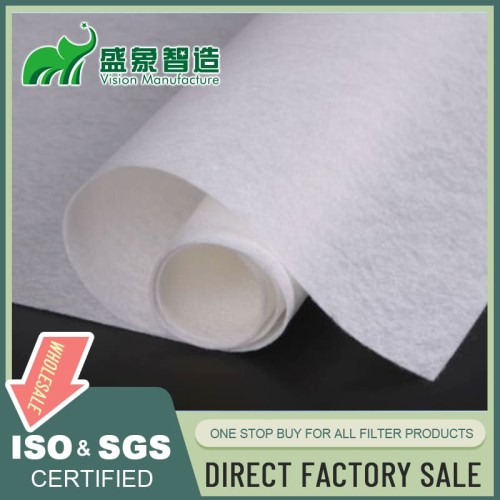
Woven PTFE Fabric: High-Performance Material for Filtration and Industrial Applications
I. Introduction
Woven PTFE (Polytetrafluoroethylene) fabric is renowned for its exceptional properties, making it indispensable in various industrial and filtration processes. This article provides an overview of PTFE, highlights the unique attributes of woven PTFE fabric, and underscores its importance in critical applications.
Woven PTFE (Polytetrafluoroethylene) fabric is renowned for its exceptional properties, making it indispensable in various industrial and filtration processes. This article provides an overview of PTFE, highlights the unique attributes of woven PTFE fabric, and underscores its importance in critical applications.
II. Properties of Woven PTFE Fabric
- Chemical Inertness: PTFE is highly resistant to most chemicals, making it ideal for harsh environments.
- High Temperature Resistance: Can withstand extreme temperatures, maintaining integrity and performance.
- Low Friction Coefficient: Offers excellent non-stick properties, reducing material buildup.
- Hydrophobic and Oleophobic Nature: Repels water and oils, facilitating cleaner operations.
- Excellent Electrical Insulation: Useful in applications requiring insulation from electrical charges.
III. Manufacturing Process
- PTFE Fiber Production: Involves the synthesis of PTFE into fibers suitable for weaving.
- Weaving Techniques: Advanced weaving methods such as plain, twill, and satin weaves are employed to produce fabrics with specific characteristics.
- Finishing and Treatment Options: Includes sintering and calendering to enhance fabric properties.
- Quality Control Measures: Rigorous testing ensures that the fabric meets stringent industry standards.
IV. Types of Woven PTFE Fabrics
- Plain Weave: Simple and sturdy, providing uniform strength and filtration capabilities.
- Twill Weave: Offers enhanced drapability and strength, suitable for dynamic applications.
- Satin Weave: Provides a smoother surface, ideal for applications requiring a slick interface.
- Specialty Weaves for Specific Applications: Custom weaves designed to meet unique industrial requirements.
V. Applications in Filtration
- Chemical Filtration: Ideal for aggressive chemical environments due to its inertness.
- High-Temperature Gas Filtration: Effectively filters gases at high temperatures without degrading.
- Liquid Filtration in Aggressive Environments: Resists corrosive liquids, maintaining filtration efficiency.
- Membrane Support in Advanced Filtration Systems: Acts as a supportive layer in sophisticated filtration setups.
VI. Other Industrial Applications
- Conveyor Belts for Food Processing: Non-stick and heat-resistant properties make it suitable for food conveyance.
- Release Sheets in Composite Manufacturing: Prevents materials from adhering to molds.
- Gaskets and Seals: Provides reliable sealing due to its chemical and temperature resistance.
- Protective Clothing and Barriers: Used in apparel and barriers where chemical protection is necessary.
VII. Performance Characteristics
- Filtration Efficiency: High efficiency in trapping particulates while maintaining airflow.
- Flow Rate Capabilities: Supports high flow rates without significant pressure drops.
- Durability and Lifespan: Long-lasting material that withstands wear and tear.
- Chemical and Temperature Resistance Limits: Performs consistently within a broad range of chemical and thermal conditions.
VIII. Design Considerations
- Fabric Thickness and Weight: Tailored to specific application needs to optimize performance.
- Pore Size and Distribution: Engineered to achieve desired filtration accuracy.
- Surface Treatments for Enhanced Performance: Treatments can improve hydrophobicity or add other functional properties.
- Integration with Support Structures: Designed to fit within various assembly frameworks, enhancing structural integrity.
IX. Installation and Maintenance
- Proper Handling Techniques: Essential to maintain the integrity of the fabric during installation.
- Installation Best Practices: Ensures optimal fit and function, preventing bypass and ensuring efficiency.
- Cleaning and Regeneration Methods: Techniques tailored to PTFE properties, extending service life.
- Inspection and Replacement Guidelines: Regular checks help maintain performance standards and ensure timely replacements.
X. Advantages Over Other Materials
- Superior Chemical Resistance: Unmatched in environments with harsh chemicals.
- Extended Service Life in Harsh Environments: Reduces the need for frequent replacements.
- Excellent Release Properties: Minimizes downtime caused by material adhesion.
- Versatility in Applications: Adaptable to a wide range of industrial uses due to its unique properties.
XI. Environmental and Safety Considerations
- PTFE Recyclability and Disposal: Focuses on sustainable disposal and recycling practices.
- Energy Efficiency in Long-term Use: Reduces operational energy demands due to its efficiency.
- Reduction of Chemical Waste in Processes: Minimizes waste production through efficient operations.
- Safety in Food and Pharmaceutical Applications: Ensures safety in sensitive applications due to its inert nature.
XII. Innovations and Future Trends
- Advanced PTFE Formulations: Enhancements in material science improve performance and environmental footprint.
- Nanofiber-enhanced PTFE Fabrics: Incorporates nanotechnology to increase filtration efficiency.
- Smart Fabrics with Integrated Sensors: Enables real-time monitoring of fabric performance and environmental conditions.
- Sustainable Manufacturing Practices: Focuses on reducing environmental impact during production.
XIII. Cost-Benefit Analysis
- Initial Investment vs. Long-term Savings: Evaluates the upfront costs against the operational savings provided by durable, high-efficiency materials.
- Performance Benefits in Various Applications: Demonstrates how PTFE fabrics outperform alternatives in demanding settings.
- Reduced Maintenance and Replacement Frequency: Lowers long-term operational costs due to durability.
XIV. Case Studies and Success Stories
Examples from various industries demonstrate how woven PTFE fabric has solved complex filtration challenges, improved process efficiency, and enhanced compliance with environmental regulations.
Examples from various industries demonstrate how woven PTFE fabric has solved complex filtration challenges, improved process efficiency, and enhanced compliance with environmental regulations.
XV. Conclusion
Woven PTFE fabric stands out as a high-performance material in filtration and industrial applications, offering unparalleled chemical resistance, durability, and versatility. As industries continue to evolve, this material is poised to meet future challenges with innovative solutions.
Woven PTFE fabric stands out as a high-performance material in filtration and industrial applications, offering unparalleled chemical resistance, durability, and versatility. As industries continue to evolve, this material is poised to meet future challenges with innovative solutions.
Leave a comment

